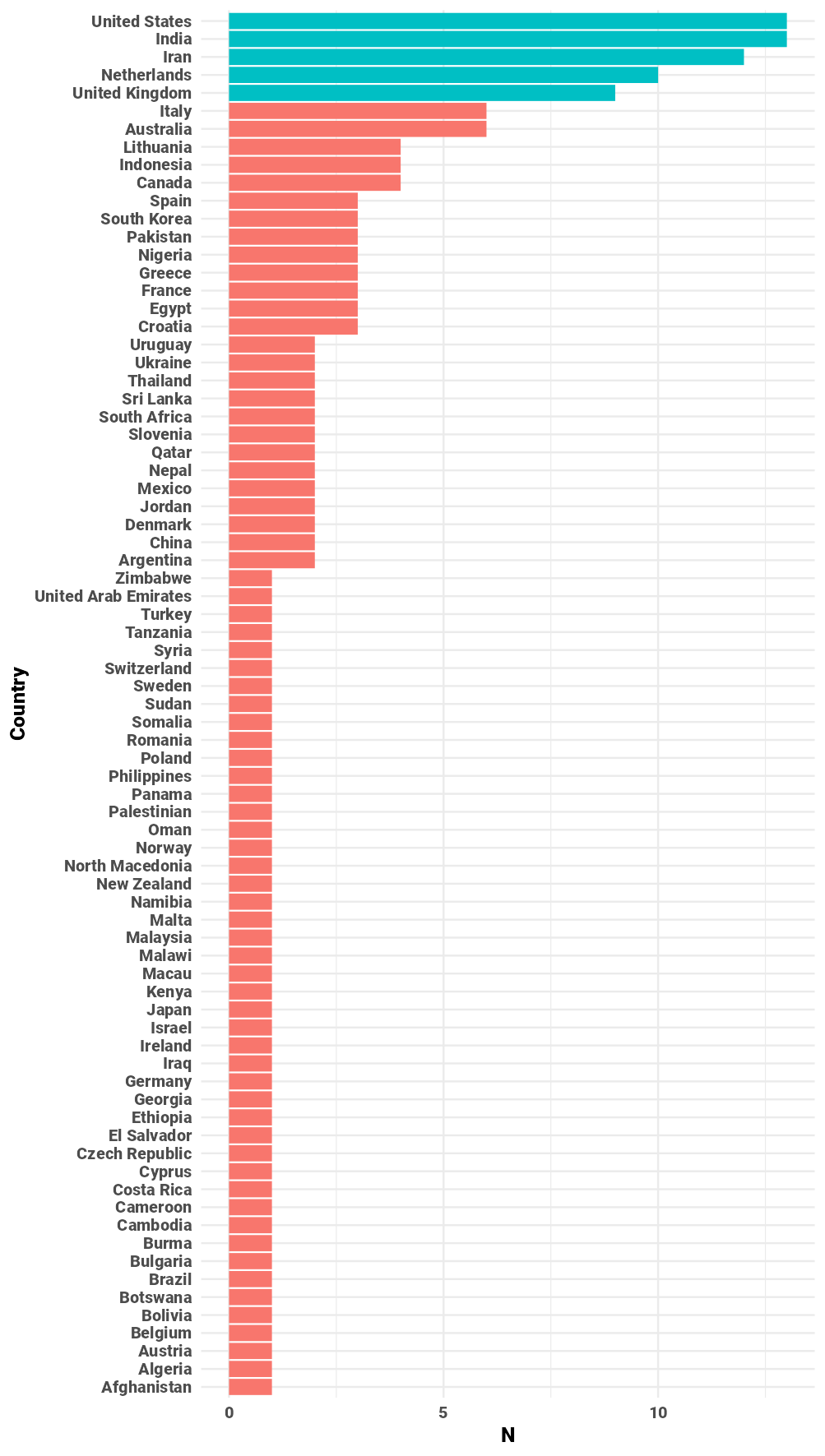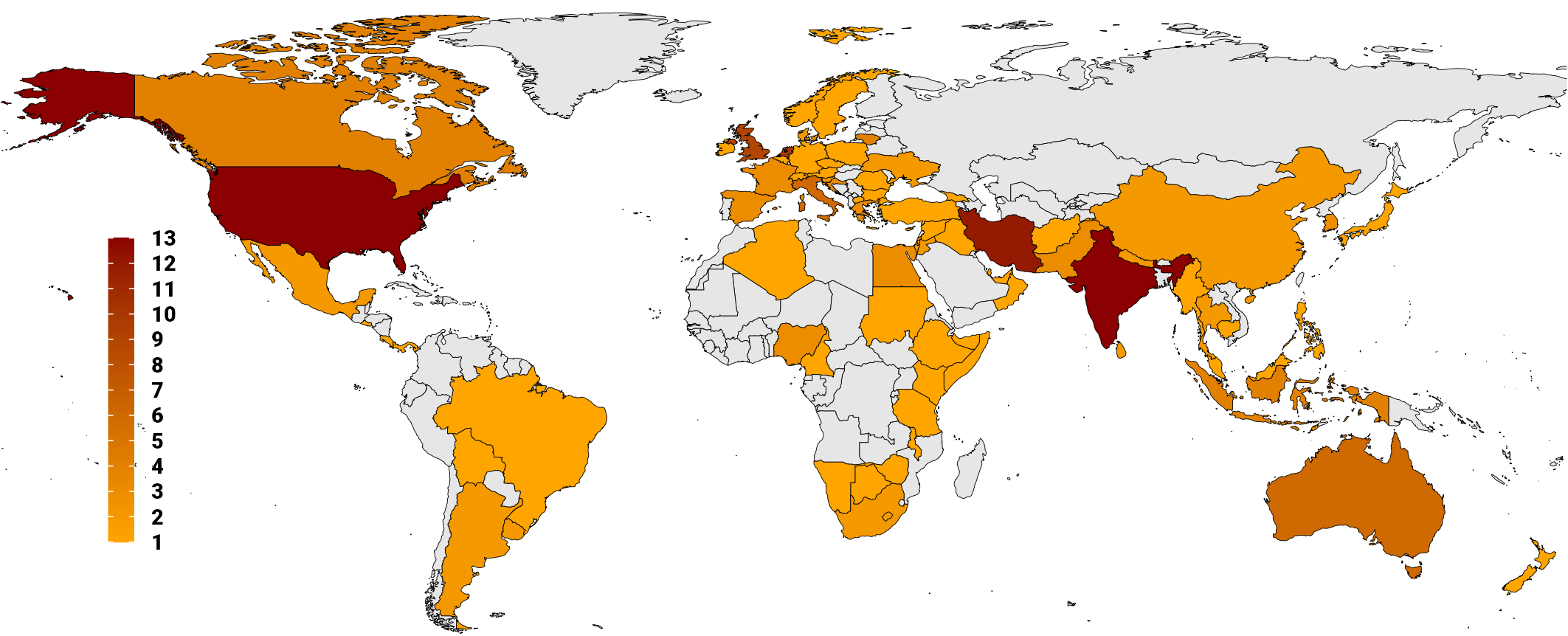13.2 شکل ۱ توزیع جهانی
- نصب و فراخوانی پکیجهای
tidyverseوplotly
Code
- وارد کردن دادهها
Rows: 177 Columns: 6
── Column specification ─────────────────────────────────────────────────────────────────────────
Delimiter: ","
chr (4): Gender, Degree, Discipline, Country
dbl (1): Age
date (1): Date
ℹ Use `spec()` to retrieve the full column specification for this data.
ℹ Specify the column types or set `show_col_types = FALSE` to quiet this message.- نگاه کلی به دادهها
df |> glimpse()Rows: 177
Columns: 6
$ Gender <chr> "Male", "Male", "Male", "Male", "Male", "Male", "Male", "Other/not disclosed…
$ Age <dbl> 69, 37, 50, 61, 54, 44, 40, 64, NA, 62, 59, 62, 44, 32, 56, 32, NA, 53, 32, …
$ Date <date> 2020-03-04, 2020-04-05, 2020-04-05, 2020-04-05, 2020-04-05, 2020-04-06, 202…
$ Degree <chr> "MD;PhD", "MD", "MD", "PhD", "MD;PhD", "MD;PhD", "MD", "PhD", "MD", "PhD", "…
$ Discipline <chr> "Addiction medicine", "Psychiatry", "General Medicine", "Psychiatry", "Psych…
$ Country <chr> "Netherlands", "Iran", "Iran", "Belgium", "Italy", "Cyprus", "Thailand", "Un…- از هر کشور چه تعداد شرکت کردهاند.
اسامی کشورها بر حسب تعداد از بیشتر به کمتر مرتب شده درون متغیر
df_countryذخیره شوند.
Code
# A tibble: 77 × 3
value count percent
<chr> <int> <dbl>
1 India 13 7.34
2 United States 13 7.34
3 Iran 12 6.78
4 Netherlands 10 5.65
5 United Kingdom 9 5.08
6 Australia 6 3.39
7 Italy 6 3.39
8 Canada 4 2.26
9 Indonesia 4 2.26
10 Lithuania 4 2.26
# ℹ 67 more rows
# ℹ Use `print(n = ...)` to see more rows- نمودار ستونی رسم کنید که سهم هر کشور برای شرکت در نظر سنجی را برحسب تعداد نشان دهد. به صورتی که رنگ نوارهای کشورهای با بیش یا مساوی ۹ نفر متفاوت از کشورهای
دیگر باشد و در نهایت نمودار را با فرمت
pngو با نامcountry-barchartدر پوشهimgذخیره کنید.
Code
country_barchart =
## importing data to ggplot
df_country |>
## ggplot panel
ggplot() +
## aesthetic
aes(x = count, y = value, fill = count >= 9) +
## chart type
geom_col() +
## custom labels
labs(
x = "N",
y = "Country",
fill = "N"
) +
## general theme
theme_minimal(base_family = "Roboto", base_size = 6) +
## custom theme
theme(
legend.position = "none",
plot.background = element_rect(fill = "white", colour = "white"),
panel.background = element_rect(fill = "white", colour = "white")
)
## save plot
ggsave(
filename = "./img/country-barchart.png",
plot = country_barchart,
dpi = 300,
width = 85,
height = 150,
units = "mm"
)
شکل 13.6: نمودار نواری تعداد افراد شرکت کننده در هر کشور
- نقشه جهان را به گونهای رسم کنید که برای هر کشور یک طیف رنگی متناسب با
تعداد افراد مشخص شده باشد.
خروجی نهایی را با فرمت
pngو با نامfigure-1-global-distributionدر پوشهimgذخیره کنید.
Code
## get global map data and save in df_world ----
df_world = map_data("world")
## check region name ----
# df_world$region |> unique()
## campare country name with region ----
# df_country[!(df_country$value %in% df_world$region), ]$value |> unique()
## correct country name ----
df_country = df_country |>
mutate(
value = value |> str_replace_all(c(
"United States" = "USA",
"Burma" = "Myanmar",
"United Kingdom" = "UK",
"Palestinian" = "Palestine"
))
)
## merge two data base ----
df_world = full_join(
## remove Antarctica area
df_world |> filter(region != "Antarctica"),
## remove Macau
df_country |> filter(value != "Macau"),
## merging global world by region with country by value ----
by = c("region"="value")
)
## check data frame after merging ----
# df_world |> filter(is.na(region))
## importing map in global_map variable ----
global_map =
## inserting data in ggplot
df_world |>
## creating ggplot panel
ggplot() +
## setting x, y, group and label in aesthetic
aes(x = long, y = lat, group = group, label = region) +
## drawing colored map base on count
geom_polygon(aes(fill = count), color = "black", lwd = 0.1) +
## setting filled color
scale_fill_gradient(
low = "orange",
high = "darkRed",
na.value = "#e6e6e6",
limits = c(1, 13),
n.breaks = 10
) +
## cutting frame and remove non-necessary area
coord_equal(xlim = c(-155, +165), ylim = c(-50, 80)) +
## setting global theme and font
theme_void(base_family = "Roboto") +
## customizing global theme
theme(
legend.title = element_blank(),
legend.position = c(0.09, 0.4),
legend.key.width = unit(3, "mm"),
legend.key.size = unit(7, "mm"),
legend.text = element_text(size = 7, face = "bold"),
plot.margin = margin(t = 0,r = 0,b = 0,l = 0, unit = "pt"),
plot.background = element_rect(fill = "white", colour = "white"),
panel.background = element_rect(fill = "white", colour = "white")
)
## save plot
ggsave(
filename = "./img/figure-1-global-distribution.png",
plot = global_map,
dpi = 300,
width = 180,
height = 73,
units = "mm"
)
شکل 13.7: نقشه توزیج جهانی تعداد افراد شرکت کننده در هر کشور
- نمودار رسم شده را به صورت واکنشگرا رسم کنید و در
فایلی به فرمت
htmlبا نامglobal-distribution-responsiveذخیره کنید.